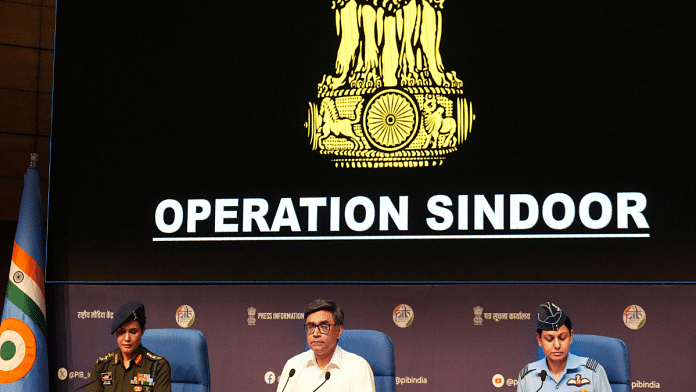Thank you dear subscribers, we are overwhelmed with your response.
Your Turn is a unique section from ThePrint featuring points of view from its subscribers. If you are a subscriber, have a point of view, please send it to us. If not, do subscribe here: https://theprint.in/
History does not always announce its arrival. There are moments when it turns with a silence that follows precision. Operation Sindoor has drawn to a pause with a clear announcement that it is far from closure. In the span of 72 hours, between the 7th and the 10th of May 2025, India not only responded to a brutal cycle of hostilities triggered by the Pahalgam terror attack, it may have also initiated something far more consequential; the systematic dismantling of Pakistan’s decades-old terror infrastructure. As dust settles over the International Border, and the Line of Control, it becomes evident this was not just a reaction. It was a redefinition. The end of the beginning of this particular standoff is here. And with it, perhaps, the beginning of the end of an era where the Pakistani state could strike India with impunity hiding behind the non-state actors.
For me six things stood out in Operation Sindoor as compared with the Surgical Strikes in PoK in 2016, and Operations Bandar (Airforce strikes) in Balakot in 2019.
Operation Sindoor and India’s New Information Warfare Doctrine
From evidence-seekers to strategic briefings: How the Indian government rewrote the playbook on public messaging during the India-Pakistan conflict 2025.
The first – information dissemination by the government. The briefings conducted by the able foreign secretary, Vikram Misri flanked by Col. Sofia Qureshi and Wg. Cdr. Vyomika Singh, and later by the Directors General of Military, Air and Naval Operations left no room for anyone to seek ‘evidence’. These briefings were without triumphalist theatrics. They were professional, clinical, layered, and quiet. The absence of spectacle was, in fact, the message. Turns out, when you speak softly and carry actual facts, the usual chorus of ‘Where’s the proof?’ finds itself muted.
Nine Terror Camps, Eleven Airbases, and a Message Delivered: India’s Precision Strike Doctrine Evolves
Operation Sindoor’s military scale dwarfs Surgical Strikes and Balakot redefining deterrence and exposing the vulnerabilities of Pakistan’s air force.
Second, the scope of operations was much wider in Operation Sindoor than in the Surgical Strikes and Operations Bandar. In the very first wave of retaliation against terror, India destroyed terror infrastructure in nine sites across Pakistani Punjab and PoK. This was followed Pakistani response and Indian counter strikes. The resoluteness and fierceness of the Indian response can be assessed from the fact that during May 9/10, we struck 11 airbases of Pakistan in a single operation. It is widely reported in Indian media that this strike destroyed 20 per cent of Pakistan’s air force assets. The particular strikes at Nur Khan in Chaklala (Close to GHQ Rawalpindi), Jacobabad (home to some of PAF’s most advanced equipment), and Sargodha (close to Kirana Hills) broke the back of their resolve and forced their DGMO to reach out to ours on the 10th of May seeking a ceasefire. Apparently, nothing accelerates a call for ceasefire quite like watching your airbases turn into very expensive potholes overnight.
Trump, Ceasefires, and the Optics of Mediation: The Fog of Peace After the Fire of War
How the US tried to frame a narrative of mediation in the Indo-Pak conflict after Operation Sindoor – and how India reclaimed control of its diplomatic story.
Third, it is interesting to note how Donald Trump milked this opportunity to stake his claim on the Nobel peace prize. The visit by Saudi Dy. FM Adel al-Jubeir to Delhi & Islamabad on the 8th of May showed that peace talks were in the works. However, the pounding which the Pakistanis received on the 8/9 May hitting their major radar and air defence installations (Chinese supplied mostly) encouraged them to reach out to the Americans to help sue for peace with India. Only a day before, Trump and JD Vance had ruled out any American role in this conflict. And yet, on the 10th of May Trump announced an American mediated ceasefire between India and Pakistan hours before Pakistan and India themselves announced it. The fact remains that the Americans only carried messages, there was no mediation, as the government of India clarified on multiple occasions thereafter. Clearly, I fail to see Trump’s statesmanship here. He appears more like a wedding crasher grabbing the mic to claim he fixed the marriage.
Targeting a Doctrine: Busting the Nuclear Bluff
India’s strike calculus in Operation Sindoor pierced not just Pakistani airspace but the psychological shield of nuclear deterrence that Islamabad had long weaponized.
Fourth, the targets were not just terror camps or Pakistani military assets, but a doctrine: the long-held assumption that India would calibrate response based on escalation risks. For decades, India’s response matrix to Pakistan-sponsored terror was shaped by the shadow of escalation anchored in the belief that crossing certain thresholds could invite nuclear retaliation. Operation Sindoor flipped that script.
I must make a mention of the alleged targeting of Kirana Hills, a site long associated with Pakistan’s covert nuclear development. While Islamabad has been tight-lipped about the extent of damage, or whether the site was hit at all, what matters more is strategic signalling. Under the 1988 Agreement on the Prohibition of Attack Against Nuclear Installations and Facilities, both countries exchange lists of protected nuclear assets every year on January 1st. Was Kirana Hills on Pakistan’s list in 2025? I don’t know. But if it was not, then that omission made it fair game. You can read more about the agreement here.
This is Part – I of a two-part series.
These pieces are being published as they have been received – they have not been edited/fact-checked by ThePrint.


